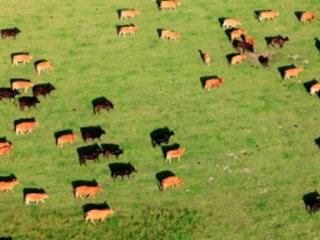 Have you ever noticed if cattle in your paddocks adopt a north-south orientation when grazing or at rest?
Have you ever noticed if cattle in your paddocks adopt a north-south orientation when grazing or at rest?
It is an observation that researchers in Germany have made while studying more than 8000 detailed satellite images of cattle on the Google Earth website.
But the question of whether the phenomenon is real and if so, what causes it, has sparked a dispute between research teams from two countries.
In 2008 researchers at the University of Duisburg-Essen in Germany said an analysis of data from Google Earth showed that cattle seem to naturally align their bodies on a north south axis along the Earth’s magnetic field lines.
A follow-up study by the same researchers showed that no such alignment occurred near electric power lines.
The phenomenon dissipated the closer the cattle were to power lines, which suggested to researchers that the lines disrupt the magneto-sensing abilities of cattle, and added further weight to their magnetic-alignment theory.
However, Czech researchers who revisited the topic earlier this year said they could not replicate the finding using different Google Earth images.
“Two independent groups participated in our study and came to the same conclusion that in contradiction to the recent findings of other researchers, no alignment of the animals and of their herds along geomagnetic field lines could be found,” the Czech researchers wrote in the Journal of Comparative Physiology.
“When in 2008 the authors started to announce their surprising findings in (the) mass media, we got the impression that this is not the way science should be made and we took a closer look.
“We found out that it is not as fantastic as it was presented.”
The German researchers have since analysed the Czech team’s replication attempt, and have claimed that it contains serious flaws.
They say half the Czech team's data should be excluded because some of the pastures are on slopes or near high-voltage power lines, for example, or because the images are too poor to make out cattle, or appear to contain hay bales or sheep instead.
“One half of their data is just noise,” German researcher Hynek Burda told the science website nature.com.
Mr Burda added that his group looked at herds as a whole, whereas the Czech researchers analysed individual cows. “Of the data that were useable, they looked only at 50pc of the cows. It’s very subjective,” Mr Burda said.
He said his team's re-analysis of the Czech data actually supported the theory that cattle can "magneto-sense".
Sönke Johnsen, who studies magneto-reception at Duke University in Durham, North Carolina, told the nature.com website that the proper unit of evaluation was probably the herd, not the individual, as the alignment of individual cows in herds was unlikely to be independent. Overall, he said that the original results, “while mysterious, still stand”.
The Czech team told nature.com that they have effectively closed the book on the research and won’t be revisiting it.
Readers who commented on the nature.com article posed their own theories to explain the north-south alignment phenomenon.
One suggested that cows would naturally adopt a north-south orientation simply to expose their sides to the warming effects of the sun as it moved across the sky from east to west.
Another commented that domestic cattle in Europe are fed large magnets at a young age which lodge in their stomach to capture and hold tiny bits of iron such as broken pieces of wire that cattle can swallow when grazing, and to prevent the pieces of iron from passing further through their gut. The suggestion was that the presence of the magnets may be influencing cattle to position themselves in alignment with magnetic fields.
However another article on the cleantechnica.com website pointed out that that the German researchers observed the same distinctive orientation in deer, very few of which would have been administered with magnets.
The magnetic mystery continues.
